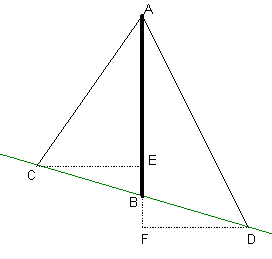 |
 |
|
Question from Aubrey, a secondary school student: finding the legth of a guy wire: |
|
Hi Aubrey. The first thing I always do with word problems in trigonometry is draw a picture, label the interesting parts and add extra lines where I think they'll be useful.
Line segment AB is the tower, AC and AD are the guy-wires and slope CD is the hill. So the length of AB is 500 ft and we want to know the lengths AC and AD. I've also drawn point E so that EB is 100 ft long and point F so that BF is 100 ft long. You are also given the fact that the hill is a 5 degree slope, Start by looking at Now look at angle Now use the same ideas to figure out the left side of the diagram. You won't need the Law of Cosines for this side, just a simple application of Pythagorus' Theorem is enough. Hope this helps, |
 |
 |
 |
